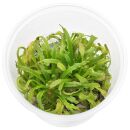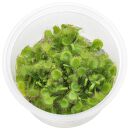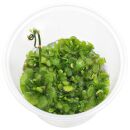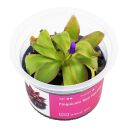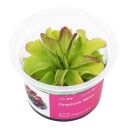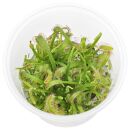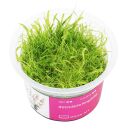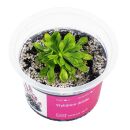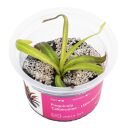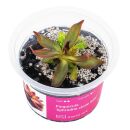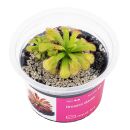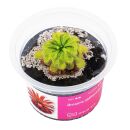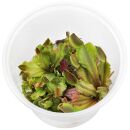- 10 - 15 cm height sundew
- Many linear-shaped leaves
- Green leafs with many red, sticky tentacles
- Small, compact sundew
- Many round-shaped leaves
- Green to light red tones
- Small, compact sundew from Asia
- Many spoon-shaped leaves
- Green to light red tones
- Unique sundew species from northern Australia
- Narrow, long leaves
- Green to dark red coloration
- Hybrid with large, lettuce-like leaves
- Bright, long-lasting flowers year-round
- Thrives at 22-29 °C, partial to full sun
- Tolerates 50-80% humidity, easy care
- Compact rosette, up to 15 cm diameter
- Hybrid of P. ehlersiae and P. moranensis
- Sticky, fleshy leaves catch insects
- Thrives at 20-25 °C, 50-80% humidity
- Bright pink to violet flowers on long stems
- Compact rosette, 10-15 cm diameter
- Hybrid of various Pinguicula species
- Red-tinted, star-shaped sticky leaves
- Compact rosette up to 12 cm diameter
- Small, violet or pink flowers year-round
- Effective natural pest control in terrariums
- Hybrid of Pinguicula agnata and Pinguicula moranensis
- Fleshy, sticky leaves catch insects
- Prefers bright, indirect light
- Violet or purple flowers on slender stems
- Compact rosette, 10-15 cm diameter
- Mexican hybrid of Pinguicula 'Zecheri' and Pinguicula 'Agnata'
- Leaves change colour from electric green to yellow and pink
- Compact plant up to 15 cm in diameter
- Blooms year-round with striking flowers
- Catches small insects
- 10 - 15 cm height sundew
- Many linear-shaped leaves
- Green to reddish leafs
- Endemic to eastern Brazil
- Terrestrial or lithophytic
- Lanceolate leaves up to 12 cm long
- Produces violet flowers up to 6 cm wide
- Thrives at 15-30 °C, high humidity
- Native to northern South America
- Grows well in moderate to intense light
- Reaches up to 15 cm in height
- Non-toxic, suitable for terrariums with animals
- Thrives in moist, acidic, nutrient-poor environments
- Compact, easy-to-care plant from Australia
- Pink flowers with trigger mechanism
- Grows up to 15 cm tall, dense rosette
- Prefers moist soil, high humidity
- Ideal for small to medium terrariums, tropical setups
- Carnivorous plant from North American wetlands
- Striking deep red pitchers, bright yellow flowers
- Thrives in partial to full sunlight, 16 hours a day
- Grows 30–70 cm tall, 30–60 cm wide
- Ideal for medium to large terrariums, aids in pest control
- Hybrid of two Pinguicula species
- Delicate pink flowers year-round
- Prefers bright, indirect light
- High humidity, 50-80%
- Compact rosette, 10-15 cm diameter
- Native to Mexico, grows in moist, shady environments
- Fleshy green leaves arranged in a rosette
- Sticky leaves for catching insects
- Violet or bluish flowers on slender stems
- Ideal for small terrariums due to compact size
- Hybrid of Pinguicula moctezumae and Pinguicula agnata
- Compact miniature form
- Long, narrow leaves up to 12 cm
- Year-round blooms
- Catches small insects
- Hybrid of Pinguicula 'Debbertiana' and Pinguicula 'esseriana'
- Red-tinted leaves under strong light
- Compact plant
- Feeds on insects
- Forms a succulent rosette
- Carnivorous plant
- Endemic to Malay Peninsula
- Red-speckled pitchers
- Inconspicuous blooms
- Prefers bright, indirect light
- Originating from Hong Kong
- Thrives in moist, boggy environments
- Requires nutrient-poor, acidic substrate
- Rosette-shaped leaves with sticky glandular hairs
- Small, delicate white or pink flowers
- Native to coastal regions of South Africa
- Round leaves with sticky tentacles, up to 5 cm in diameter
- Bright red tentacles
- Moist, nutrient-poor soils
- Ideal for small to medium terrariums
- Native to the tropical rainforests of Queensland, Australia
- Bright green leaves with sticky tentacles
- Delicate pink flowers on long flower stalks
- Thrives at temperatures between 15 and 30 °C
- Prefers shady, moist environments
- Sticky, spatula-shaped leaves catch insects
- Small, delicate pink to purple flowers
- Ideal for small to medium terrariums, tropical setups
- Thrives at 15-30°C, high humidity
- Bizarre carnivorous plant
- Unique snap traps
- Deep red colouring with plenty of light
Terrarium plants - Green up your terrarium!
One of the most popular types of plants are the "carnivorous plants". They are surrounded by an aura of the spectacular and also a little creep. Although the carnivorous plants "only" prey on animals ranging from the smallest to a few centimetres in size, they impress with their diversity and the sophistication of their capture mechanisms.
Animal-catching plants occur in most climatic zones of the earth, but in more or less nutrient-poor locations. These can be raised bogs, nutrient-poor ponds, damp sandy areas, trickling rocks or rainforests with poor, acidic soil. Very diverse and rich in form are, for example, the bladderworts (Utricularia) with their trap bladders, with aquatic, terrestrial or epiphytic species that flower beautifully. Even the humped or floating bladderwort (Utricularia gibba), which can sometimes be a nuisance in aquariums, can grow on merely wet surfaces and adorns itself with delicate yellow flowers. The butterworts (Pinguicula) belong to the same family. Generally known is the Venus flytrap (Dionaea muscipula) from the Atlantic coastal plain of the USA. Close to this are the countless, often small sundew species (Drosera), which are widespread from Australia, Africa and South America to the far north. Far larger are the tropical pitcher plants, or monkey cups (Nepenthes) with over a hundred species. They have a purely tropical distribution, especially on the islands of Southeast Asia. Similar "pitchers" have the trumpet pitchers (Sarracenia) from bogs in North America, which are not closely related to Nepenthes.
Carnivorous plants have a competitive advantage in nature because they have an additional source of nutrients at their disposal by catching and digesting animals. But they also photosynthesise like other plants and do not need to be fed in cultivation in order to thrive. The cultivation requirements can vary greatly depending on the species, but in general the substrate should not be too rich in nutrients.


